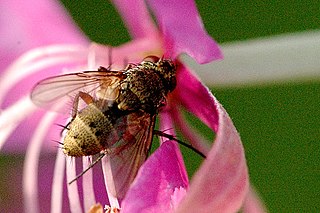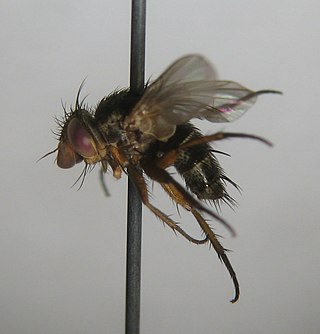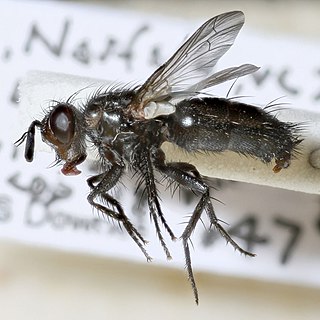
Ceranthia is a subgenus of flies in the family Tachinidae. Some consider this to be a subgenus of Siphona, most European workers seem content that this is a genus in its own right.
Actia maksymovi is a Palearctic species of fly in the family Tachinidae.
Actia dubitata is a Palearctic species of fly in the family Tachinidae.
Actia nigroscutellata is a species of tachinid flies in the genus Actia of the family Tachinidae. It is native to Northern Europe, mostly Scandinavia, where it is rare.

Actia pilipennis is a Palearctic species of fly in the family Tachinidae.

Siphonini is a tribe of flies in the family Tachinidae.
Actia nudibasis is a Palearctic species of flies in the family Tachinidae.

Siphona (Aphantorhaphopsis) verralli is a Palearctic species of fly in the family Tachinidae.

Ceromya bicolor is a Palearctic species of fly in the family Tachinidae.
Siphona (Ceranthia) abdominalis is a tachinid fly in the subgenus Ceranthia of the family Tachinidae. The species was first described by Jean-Baptiste Robineau-Desvoidy in 1830.
Siphona (Ceranthia) tenuipalpis is a species of tachinid flies in the subgenus Ceranthia of the family Tachinidae.
Siphona (Ceranthia) tristella is a species of tachinid flies in the subgenus Ceranthia of the family Tachinidae.
Entomophaga exoleta is a species of tachinid flies in the genus Entomophaga of the family Tachinidae.

Entomophaga nigrohalterata is a species of tachinid flies in the genus Entomophaga of the family Tachinidae.
Siphona setosa is a Palearctic species of fly in the family Tachinidae.
Siphona variata is a Palearctic species of fly in the family Tachinidae.

Siphona cristata is a Palearctic species of fly in the family Tachinidae.

Siphona geniculata is a Palearctic species of fly in the family Tachinidae.

Siphona pauciseta is a Palearctic species of fly in the family Tachinidae.

Germaria angustata is a species of tachinid flies in the genus Germaria of the family Tachinidae.









